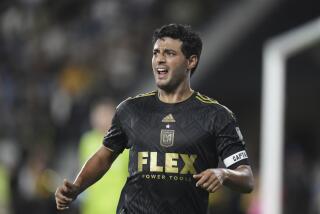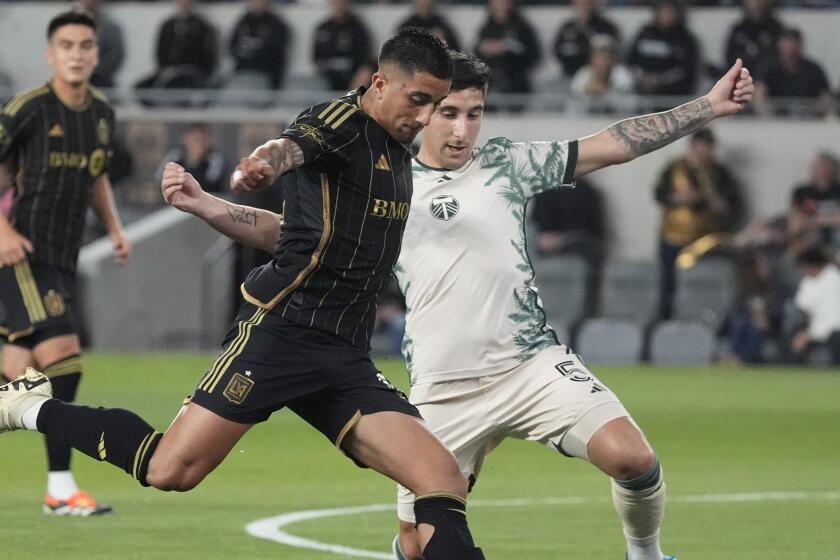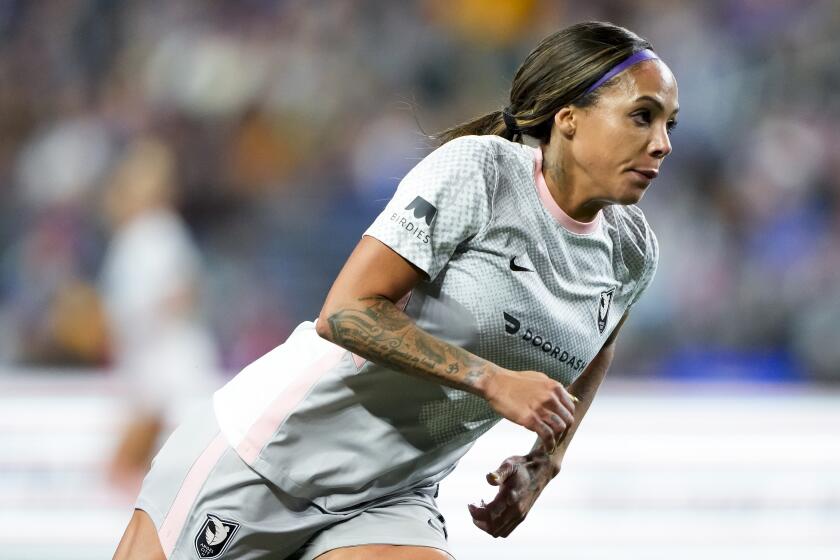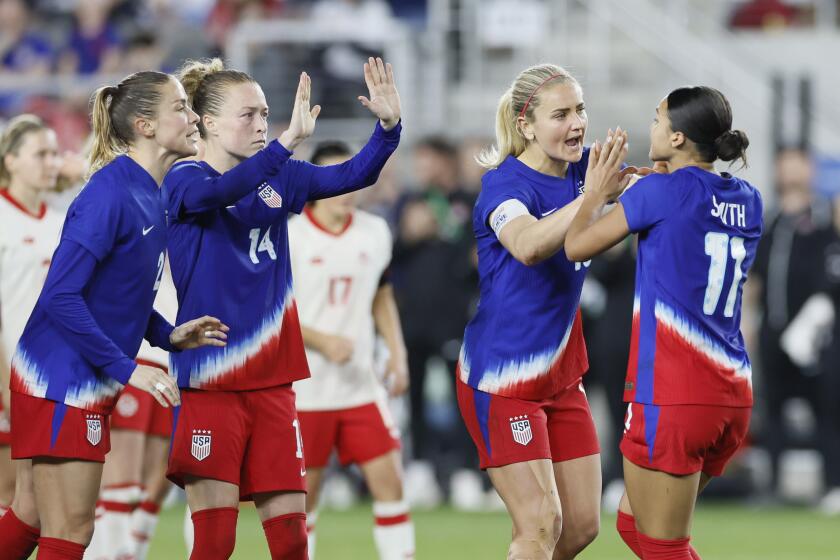Mexico tries to blend young soccer standouts with veterans
One grew up poor on the crime-plagued streets of Tepito, one of Mexico City’s most notorious neighborhoods. The other was born into one of the country’s most prominent families in pastoral Guadalajara.
One dropped out of school as a teen, dated a soap-opera star and fathered two children with different women. The other is studying business administration at one of Mexico’s top universities and still lives at home, where his parents require him to keep his room clean.
If not for soccer it’s unlikely Cuauhtemoc Blanco, a rough-hewn, quick-tempered 37-year-old from the barrio would have ever met Javier Hernandez, a soft-spoken, baby-faced 21-year-old from the countryside. Yet, for the next two months their fortunes will be inextricably linked on Mexico’s World Cup team, Blanco as the aging playmaker who gets by now on guts and guile and Hernandez as the wide-eyed, marvelously talented rookie who leads the team in scoring.
“We’re hoping that this combination works,” said Blanco, who played in his first World Cup when Hernandez was still in grade school.
Arguably the best — and undoubtedly the most adored — Mexican player of his generation, Blanco is a folk hero at home, where he was voted most valuable player in Mexico’s Primera Division several times.
Blanco has a weekly TV show, writes an occasional syndicated newspaper column and is mobbed in public wherever he goes. And though 2007 marked his last game for Club America, the Primera Division soccer team that is Mexico’s version of the New York Yankees, his yellow No. 10 America jersey remains among the most popular in Mexico.
That popularity runs deep on both sides of the border. When Blanco left Mexico for the Chicago Fire of the Major League Soccer three years ago, more than 6,000 fans showed up at his first news conference. And when he agreed to sign autographs at a supermarket in Wilmington recently, fans began lining up more than eight hours before Blanco was to arrive.
With that fame came fortune in the form of a three-year contract with the MLS, which paid him $2.7 million per season, making him the league’s second-best-paid player behind the Galaxy’s David Beckham.
Missing, however, is World Cup success. Although Blanco scored goals in both his previous trips to the quadrennial championship, Mexico won only three of the eight Cup games he played in. This year, he promises, it will be different.
“When I’ve gone to the World Cup, I’ve gone trying to win a championship,” he said. “We have the capacity to beat anybody. We’ve demonstrated that. And we’re going forward with that intention.”
A step slower and 15 pounds heavier than in his prime, Blanco is also going forward with a new role.
Mexico’s biggest star now is Hernandez, who recently became the first Mexican to sign with legendary Manchester United, a transfer deal that will cost the English club a reported $12.3 million. That makes Blanco, the oldest player on Mexico’s roster, something of an elder statesman; a counselor, tutor and teacher to a team with an average age in the mid-20s.
“He’s providing something very valuable, if not on the field then off the field,” said Mexican Coach Javier Aguirre.
For all the creativity Blanco brought to the field, though, he earned a reputation as brooding and temperamental off it. Yet, friends say that’s mainly a role he plays for the media, much of which he distrusts.
In Chicago, as in Mexico, Blanco made frequent trips to grade schools and hospitals, often in the company of then-girlfriend Rossana Najera, a Mexican actress. Rarely would he go if cameras were present, however, believing the publicity robbed the visits of their sincerity.
He does his best work with the national team in private as well, quietly calling aside many of Mexico’s young players to share the wisdom of his experience.
“I talk with him,” Hernandez has told reporters. “He told me there’s a long road ahead, that I’m young, and not to get a big head. Keep my feet on the ground and always stay calm.”
That’s advice Hernandez probably could have gotten at home, since his father and grandfather played on World Cup teams, his grandfather in 1954 and his father in 1986, the last time Mexico advanced beyond the second round.
But he inherited more than just soccer talent from his father. As an infant, Javier Hernandez Sr. was called Chicharo, or pea, for his dark-green eyes. He passed that trait, and the nickname, on to his son, who is known as chicharito, the little pea.
If Blanco is an icon in Mexico, Chicharito is a revelation. Although he turned pro at 15 and scored for Mexico in the U-20 World Cup in 2007, by last spring he was languishing on the bench for Chivas of Guadalajara. Making it to the World Cup seemed about as likely as making it to the moon, so Hernandez told his father and his agent he wanted to quit soccer and go to school full time.
That despair began to fade about nine months ago, when Hernandez worked his way, tentatively, into the Chivas lineup during the second of the Mexican Primera Division’s two annual tournaments, scoring 11 times in 17 games. That earned him a call-up to the national team for a September “friendly” against Colombia, in which he assisted on Mexico’s only goal.
Invited back for Mexico’s first three World Cup warmups this winter, Hernandez was even better, scoring four times.
Then came the offer to join Manchester United, the most stunning proof that Hernandez had arrived.
But it’s also proof that a new era is dawning in Mexican soccer. During Blanco’s heyday, few Mexican stars ventured to Europe, preferring to play at home. Blanco played only 23 games on loan to Spain’s Real Valladolid and scored only three times. This year as many as 10 players that probably will be on Mexico’s World Cup roster are playing on top European clubs such as Barcelona, Arsenal and La Coruna.
Hernandez may be the best of the bunch, and he can score just as easily with his head as with his feet.
But to do that he’ll need Blanco to get him the ball. That’s where the vast differences between Hernandez, the brightest light in Mexico’s soccer future, and Blanco, the fading icon of its recent past, begin to give way to their common goal.
“Time passes,” Blanco said, “and young players come along ready to play. That’s the beauty of soccer. Young players coming along with the hunger to succeed.
“The objective now is to try to support the younger players.”







